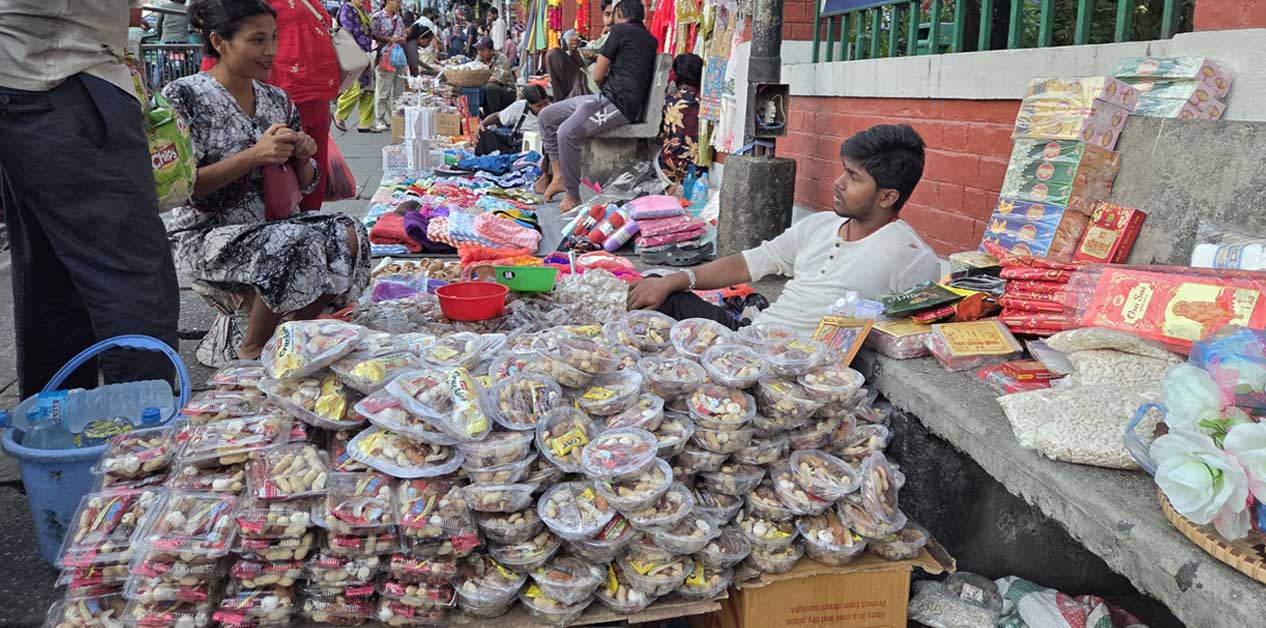
Bhai Masala (sweets and dry fruits for brothers in Tihar), decorative lights, and flowers generate massive sales.

KATHMANDU: Tihar means light, flowers, and the vibrancy of colors. The festival is also observed as the worship of Goddess Lakshmi, the goddess of wealth and prosperity. But its significance extends beyond religious devotion; in Nepal, Tihar is the second largest festival driving the national economy.
Every year, dry fruits alone account for trade worth around Rs 2.5 billion during Tihar. Known as Bhai Masala (sweets and dry fruits for brothers), dry fruits play a crucial role in energizing the economy. According to the Department of Customs, dry fruits worth Rs 2.45 billion were imported during the months from mid-July to mid-September alone this year.
The most demanded dry fruits during Tihar include walnuts, almonds, cashews, pistachios, and raisins. Other items, like figs, areca nuts, and apricots, are also heavily consumed. In the first two months of the fiscal year, coconuts worth Rs 267.3 million were imported, followed by walnuts worth Rs 246.4 million and pistachios worth Rs 40.6 million.
Raisins alone, a popular item in Nepali households, saw imports worth Rs 376.6 million in the same period. Additionally, mixed dry fruits valued at Rs 174.1 million were imported.
According to customs data, Nepal imports dry fruits mainly from Australia, China, India, Kuwait, Malaysia, Oman, Qatar, Saudi Arabia, Vietnam, Bahrain, Benin, Brunei, Egypt, Israel, Korea, Mozambique, Nigeria, Singapore, South Africa, the UAE, the UK, and the USA. In fiscal year 2024/25, coconuts worth Rs 861.4 million, cashews worth Rs 532.2 million, walnuts worth Rs 1.04 billion, and raisins worth Rs 413.8 million were imported.
During the same period, imports of areca nuts alone were worth Rs 1.04 billion, mainly from India, Indonesia, and Qatar. Interestingly, Nepal also re-exports some of these imported areca nuts abroad.
Besides dry fruits, fruits and sweets see the highest sales during Tihar. Although fruits are imported year-round, their consumption peaks during Dashain and Tihar. Sweet shops also experience their busiest period during this festival. Gold and silver trading likewise increases sharply. The Nepal Rastra Bank, which traditionally issued gold coins for Tihar, did not mint them this year but instead sold silver coins bearing images of Goddess Lakshmi, Lord Ganesh, Gajalakshmi, and a cow. By Sunday, the bank had sold silver coins equivalent to 410 kilograms.
Decoration lights worth Rs 650 million
Fairy lights are among the most traded items during Tihar. Lighting homes has long been a tradition, especially on Lakshmi Puja, when electricity consumption peaks. According to the Nepal Electricity Authority, last year’s Lakshmi Puja recorded electricity consumption of 1,602 megawatts. This was the highest consumption of the year, largely due to decorative lighting.
This year, decorative lights worth around Rs 650 million were imported, said Resham Prasad Devkota, president of the Federation of Electrical Entrepreneurs of Nepal. Over 90 percent of these lights came from China.
Flowers worth Rs 450 million
During Tihar, garlands are used to decorate homes and offices, while on Bhai Tika, sisters place them around their brothers’ necks to celebrate the festival with warmth and joy. The number of farmers engaged in flower cultivation specifically for Tihar has been increasing every year.
The most in-demand flowers during the festival are marigold (Sayapatri), chrysanthemum (Godawari), and globe amaranth (Makhmali). According to Rajesh Bhakta Shrestha, president of the Floriculture Association Nepal, flower trade worth more than Rs 400 million is expected this Tihar.
He said, “The flower business has been growing every year. About 90 percent of flowers consumed during Tihar are domestically produced, while the remaining 10 percent are illegally imported from India.”
According to Shrestha, the Floriculture Association has around 600 entrepreneurs, and nearly 12,000 people are directly employed in the flower business across the country.
Since Tihar arrived earlier this year, many flowers have not fully bloomed, resulting in a limited supply in the market, Shrestha said. “Because the festival came sooner than usual, not all flowers on the plants have blossomed. As a result, the market has not received enough supply, and farmers haven’t been able to sell in large quantities. During such times, middlemen tend to charge higher prices, so consumers should remain cautious,” he added.
Flowers grown in Nepal have also started reaching foreign markets. With the growing presence of Nepalis abroad, garlands made from globe amaranth flowers are now being exported to countries like Australia, the United Kingdom, and the United States.
According to the Department of Customs, Nepal exported various types of flowers worth around Rs 4 billion during the first two months of the current fiscal year (mid-July to mid-September).